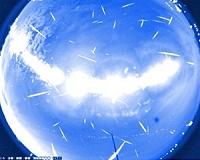 |
Science@NASA Huntsville AL (SPX) Dec 09, 2010 The Geminid meteor shower, which peaks this year on Dec. 13th and 14th, is the most intense meteor shower of the year. It lasts for days, is rich in fireballs, and can be seen from almost any point on Earth. It's also NASA astronomer Bill Cooke's favorite meteor shower-but not for any of the reasons listed above. "The Geminids are my favorite," he explains, "because they defy explanation." Most meteor showers come from comets, which spew ample meteoroids for a night of 'shooting stars.' The Geminids are different. The parent is not a comet but a weird rocky object named 3200 Phaethon that sheds very little dusty debris-not nearly enough to explain the Geminids. "Of all the debris streams Earth passes through every year, the Geminids' is by far the most massive," says Cooke. "When we add up the amount of dust in the Geminid stream, it outweighs other streams by factors of 5 to 500." This makes the Geminids the 900-lb gorilla of meteor showers. Yet 3200 Phaethon is more of a 98-lb weakling. 3200 Phaethon was discovered in 1983 by NASA's IRAS satellite and promptly classified as an asteroid. What else could it be? It did not have a tail; its orbit intersected the main asteroid belt; and its colors strongly resembled that of other asteroids. Indeed, 3200 Phaethon resembles main belt asteroid Pallas so much, it might be a 5-kilometer chip off that 544 km block. "If 3200 Phaethon broke apart from asteroid Pallas, as some researchers believe, then Geminid meteoroids might be debris from the breakup," speculates Cooke. "But that doesn't agree with other things we know." Researchers have looked carefully at the orbits of Geminid meteoroids and concluded that they were ejected from 3200 Phaethon when Phaethon was close to the sun-not when it was out in the asteroid belt breaking up with Pallas. The eccentric orbit of 3200 Phaethon brings it well inside the orbit of Mercury every 1.4 years. The rocky body thus receives a regular blast of solar heating that might boil jets of dust into the Geminid stream. Could this be the answer? To test the hypothesis, researchers turned to NASA's twin STEREO spacecraft, which are designed to study solar activity. Coronagraphs onboard STEREO can detect sungrazing asteroids and comets, and in June 2009 they detected 3200 Phaethon only 15 solar diameters from the sun's surface. What happened next surprised UCLA planetary scientists David Jewitt and Jing Li, who analyzed the data. "3200 Phaethon unexpectedly brightened by a factor of two," they wrote. "The most likely explanation is that Phaethon ejected dust, perhaps in response to a break-down of surface rocks (through thermal fracture and decomposition cracking of hydrated minerals) in the intense heat of the Sun." Jewett and Li's "rock comet" hypothesis is compelling, but they point out a problem: The amount of dust 3200 Phaethon ejected during its 2009 sun-encounter added a mere 0.01% to the mass of the Geminid debris stream-not nearly enough to keep the stream replenished over time. Perhaps the rock comet was more active in the past ...? "We just don't know," says Cooke. "Every new thing we learn about the Geminids seems to deepen the mystery." This month Earth will pass through the Geminid debris stream, producing as many as 120 meteors per hour over dark-sky sites. The best time to look is probably between local midnight and sunrise on Tuesday, Dec. 14th, when the Moon is low and the constellation Gemini is high overhead, spitting bright Geminids across a sparkling starry sky. Bundle up, go outside, and savor the mystery.
Share This Article With Planet Earth
Related Links NASA Meteoroid Environment Office Asteroid and Comet Impact Danger To Earth - News and Science
 Geminids Meteor Shower: 'Up All Night' With NASA
Geminids Meteor Shower: 'Up All Night' With NASAHuntsville AL (SPX) Dec 06, 2010 Baby, it's cold outside - but you can still enjoy the best meteor shower of the year. The 2010 Geminid meteor shower promises to be lively, with realistic viewing rates of 50-80 meteors per hour and potential peaks reaching 120 meteors per hour. Anytime between Dec. 12-16 is a valid window for Geminid-watching, but the night of Dec. 13-14 is the anticipated peak. b>About the Chats br> /b> ... read more |
|
| The content herein, unless otherwise known to be public domain, are Copyright 1995-2010 - SpaceDaily. AFP and UPI Wire Stories are copyright Agence France-Presse and United Press International. ESA Portal Reports are copyright European Space Agency. All NASA sourced material is public domain. Additional copyrights may apply in whole or part to other bona fide parties. Advertising does not imply endorsement,agreement or approval of any opinions, statements or information provided by SpaceDaily on any Web page published or hosted by SpaceDaily. Privacy Statement |